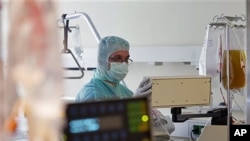German officials say initial tests show that sprouts from an organic farm in the country's north are not the cause of an E. coli outbreak that has left 22 people dead and infected more than 2,200 others.
Lower Saxony state's agriculture ministry said Monday that 23 of 40 samples taken from the suspected farm have tested negative for the bacteria. Except for one woman who died in Sweden after a visit to Germany, all of the fatalities have been within German borders.
Health authorities say the majority of those infected are in Germany. Eleven other European nations and the United States have reported 90 infected people, nearly all of whom have recently been in northern Germany.
European Union agriculture ministers will meet Tuesday in Luxembourg to discuss the crisis and its economic impact, which includes a ban by Russia on all vegetables from the EU. The ministers at the emergency meeting will discuss how to compensate farmers affected by the E. coli outbreak.
|
E. coli and how it is transmitted E. coli is an abbreviation for Escherichia, which is a large and diverse group of bacteria. Most strains are harmless, others can cause illness. Symptoms include stomach cramps, diarrhea and vomiting. The major source is cattle, but other animals, foods and liquids may spread contamination to people.
|
German officials had initially blamed the cause of the outbreak on lettuce, tomatoes and cucumbers from Spain.
The outbreak is the deadliest in modern history to involve E. coli, and appears to be the second- or third-largest in terms of the number of people who have become ill. Scientists say the bacteria is a previously unknown genetic recombination of two different E. coli strains.
Symptoms of E. coli infection include stomach cramps, diarrhea, fever and vomiting.
Some information for this report was provided by AP and AFP.










